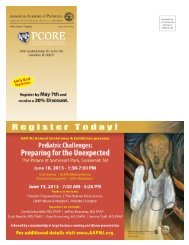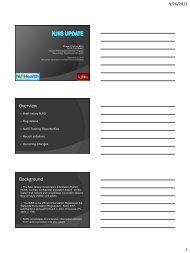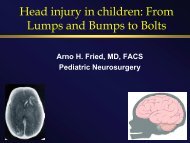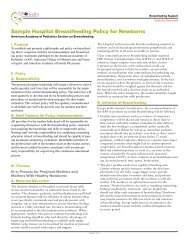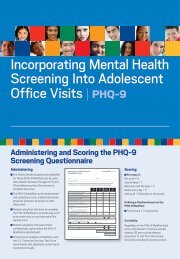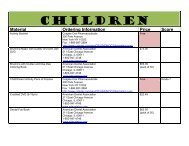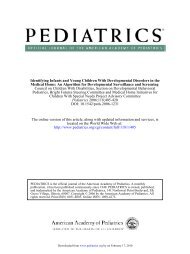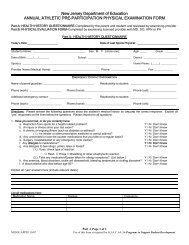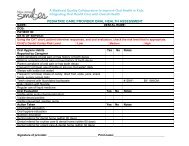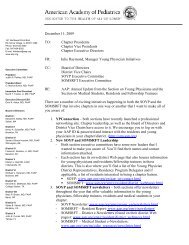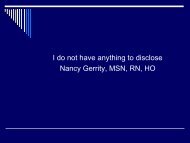PSC-Y - New Jersey Chapter, American Academy of Pediatrics
PSC-Y - New Jersey Chapter, American Academy of Pediatrics
PSC-Y - New Jersey Chapter, American Academy of Pediatrics
You also want an ePaper? Increase the reach of your titles
YUMPU automatically turns print PDFs into web optimized ePapers that Google loves.
Incorporating Mental Health<br />
Screening Into Adolescent<br />
Office Visits | <strong>PSC</strong>-Y<br />
Administering and Scoring the <strong>PSC</strong>-Y<br />
Screening Questionnaire<br />
Administering<br />
The youth self-report version <strong>of</strong> the Pediatric<br />
Symptom Checklist (<strong>PSC</strong>-Y) can be used<br />
with patients between the ages <strong>of</strong> 11 and 18<br />
and takes less than five minutes to complete<br />
and score.<br />
The <strong>PSC</strong>-Y can be administered and scored<br />
by a nurse, medical technician, physician<br />
assistant, physician or other <strong>of</strong>fice staff.<br />
Patients should be left alone to complete<br />
the <strong>PSC</strong>-Y in a private area, such as an exam<br />
room or a private area <strong>of</strong> the waiting room.<br />
Patients should be informed <strong>of</strong> their<br />
confidentiality rights before the <strong>PSC</strong>-Y is<br />
administered.<br />
It is recommended that parents are informed<br />
that a mental health checkup will be<br />
administered as part <strong>of</strong> the exam.<br />
The <strong>American</strong> <strong>Academy</strong> <strong>of</strong> <strong>Pediatrics</strong><br />
recommends that mental health screening<br />
be conducted annually.<br />
Scoring<br />
Each item on the <strong>PSC</strong>-Y is scored<br />
as follows:<br />
Never = 0 Sometimes = 1 Often = 2<br />
To calculate the score, add all <strong>of</strong> the item<br />
scores together:<br />
Total Score = ______ (range 0–70)<br />
If items are left blank, they are scored as 0.<br />
If four or more items are left blank, the<br />
questionnaire is considered invalid.<br />
Note if either suicide question has been<br />
endorsed (Questions 36 and 37).<br />
Score is positive if:<br />
Total Score ≥ 30<br />
OR<br />
Recent suicidal ideation is reported (Q36)<br />
OR<br />
Past suicide attempt is reported (Q 37)
Interpreting the Screening Results<br />
Patients that score positive on<br />
their <strong>PSC</strong>-Y should be evaluated by<br />
the primary care provider (PCP) to<br />
determine if the symptoms endorsed<br />
on the questionnaire are significant,<br />
causing impairment and warrant a<br />
referral to a mental health specialist<br />
or follow-up or treatment by the PCP.<br />
For patients who score negative<br />
on the <strong>PSC</strong>-Y, it is recommended<br />
that the PCP briefly review the<br />
symptoms marked as “sometimes”<br />
and “<strong>of</strong>ten” with the patient.<br />
For help assessing mental<br />
illness and suicide risk, order the<br />
TeenScreen Post-Screening<br />
Interview Guide.<br />
The questionnaire indicates only<br />
the likelihood that a youth is at risk<br />
for a significant mental health<br />
problem or suicide; its results are<br />
not a diagnosis or a substitute for<br />
a clinical evaluation.<br />
Internalizing<br />
Problems<br />
( i.e., Depression<br />
or Anxiety)<br />
• Feel sad, unhappy<br />
• Worry a lot<br />
• Feel hopeless<br />
• Seem to be having<br />
less fun<br />
• Down on yourself<br />
Non-Categorized Items<br />
• Complain <strong>of</strong> aches<br />
or pains<br />
• Spend more time alone<br />
• Tire easily, little energy<br />
• Do not show feelings<br />
• Have trouble with<br />
teacher<br />
Individual Problem Areas (For Interpretation Only)<br />
Attention<br />
Problems<br />
( i.e., ADHD)<br />
• Fidgety, unable to<br />
sit still<br />
• Distract easily<br />
• Act as if driven<br />
by motor<br />
• Daydream too much<br />
• Have trouble<br />
concentrating<br />
• Less interested in<br />
school<br />
• Are afraid <strong>of</strong> new<br />
situations<br />
• Are irritable, angry<br />
• Less interested in<br />
friends<br />
Externalizing<br />
Problems<br />
( i.e., Conduct Disorder,<br />
Oppositional Defiant<br />
Disorder)<br />
• Fight with other children<br />
• Tease others<br />
• Do not listen to rules<br />
• Refuse to share<br />
• Do not understand<br />
other people’s feelings<br />
• Blame others for your<br />
troubles<br />
• Take things that do<br />
not belong to you<br />
• Absent from school<br />
• School grades dropping<br />
• Visit doctor with doctor<br />
finding nothing wrong<br />
• Have trouble sleeping<br />
• Feel that you are bad<br />
Suicidality<br />
(if either question<br />
is endorsed, further<br />
assess for suicidal<br />
thinking and behavior<br />
and depression)<br />
• Recent suicide<br />
ideation<br />
• Prior suicide<br />
attempt<br />
• Want to be with parent<br />
more than before<br />
• Take unnecessary risks<br />
• Get hurt frequently<br />
• Act younger than<br />
children your age<br />
Engaging and<br />
Informing Parents<br />
Inform parents <strong>of</strong> the screening<br />
results (positive or negative), and<br />
recommendations for referral, treatment or<br />
follow-up.<br />
Provide parents with information about<br />
the next steps and <strong>of</strong>fer support and<br />
assistance with finding or making an<br />
appointment with a behavioral health<br />
specialist.<br />
Give information to parents about why the<br />
referral is being made, how the services<br />
you are referring can help, and details about<br />
where you are sending them.<br />
Compile a list <strong>of</strong> appropriate referral<br />
resources in the community and share that<br />
list with families <strong>of</strong> patients that receive a<br />
referral.<br />
Work with the patient’s existing insurance<br />
benefit to determine the referral resources<br />
that are available to them.<br />
Obtain written permission from parents<br />
to allow the transfer <strong>of</strong> information<br />
between the PCP and the behavioral health<br />
specialist who accepts the referral.<br />
For more information about making<br />
a referral, please refer to our<br />
Guide to Referral.<br />
Coding and Payment<br />
The following is a comprehensive list <strong>of</strong> relevant codes that may be used to bill for mental<br />
health checkups. These codes are not guaranteed to work with all payers.<br />
Mental Health Screening<br />
96110 – Developmental screening, with interpretation and report, per standardized instrument<br />
form.<br />
HCPCS Level II Code G0451 - Developmental testing with interpretation and report, per<br />
standardized instrument form.<br />
Health Risk Assessment Code<br />
99420 – This code may be used for the administration and interpretation <strong>of</strong> a health risk<br />
assessment instrument.<br />
Evaluation and Management Codes (E/M)<br />
PCPs may report an <strong>of</strong>fice or outpatient<br />
E/M code using time as the key factor<br />
when a limited screening test is administered<br />
along with an E/M service.<br />
Modifier 25<br />
Modifier 25 tells insurers that the particular<br />
visit is different; it should be added to the<br />
<strong>of</strong>fice / outpatient visit to indicate that a<br />
significant, separately identifiable E/M service<br />
was performed in addition to the preventive<br />
medicine visit. Note that many insurers do not<br />
reimburse for modifier 25.<br />
Established Patients<br />
Relevant ICD-9 (Diagnosis) Codes<br />
V20.2 – Well-child, preventative health visits<br />
V79.8 – Special screening exam for mental disorders and developmental handicaps<br />
V40.0 – Mental and behavioral health problems<br />
<strong>New</strong> Patients<br />
99211 (5 minutes) 99201 (10 minutes)<br />
99212 (10 minutes) 99202 (20 minutes)<br />
99213 (15 minutes) 99203 (30 minutes)<br />
99214 (25 minutes) 99204 (45 minutes)<br />
99215 (40 minutes) 99205 (60 minutes)<br />
For more information about coding and<br />
payment for mental health issues, please<br />
refer to our Guide to Coding and Payment.
A Survey From Your Healthcare Provider — <strong>PSC</strong>-Y<br />
Name Date ID<br />
Please mark under the heading that best fits you or circle Yes or No Never 0 Sometimes 1 Often 2<br />
- 1. Complain <strong>of</strong> aches or pains<br />
- 2. Spend more time alone<br />
- 3. Tire easily, little energy<br />
4. Fidgety, unable to sit still<br />
- 5. Have trouble with teacher<br />
- 6. Less interested in school<br />
7. Act as if driven by motor<br />
8. Daydream too much<br />
9. Distract easily<br />
- 10. Are afraid <strong>of</strong> new situations<br />
11. Feel sad, unhappy<br />
- 12. Are irritable, angry<br />
13. Feel hopeless<br />
14. Have trouble concentrating<br />
- 15. Less interested in friends<br />
16. Fight with other children<br />
- 17. Absent from school<br />
- 18. School grades dropping<br />
19. Down on yourself<br />
- 20. Visit doctor with doctor finding nothing wrong<br />
- 21. Have trouble sleeping<br />
22. Worry a lot<br />
- 23. Want to be with parent more than before<br />
- 24. Feel that you are bad<br />
- 25. Take unnecessary risks<br />
- 26. Get hurt frequently<br />
27. Seem to be having less fun<br />
- 28. Act younger than children your age<br />
29. Do not listen to rules<br />
- 30. Do not show feelings<br />
31. Do not understand other people’s feelings<br />
32. Tease others<br />
33. Blame others for your troubles<br />
34. Take things that do not belong to you<br />
35. Refuse to share<br />
36. During the past three months, have you thought <strong>of</strong> killing yourself? Yes No<br />
37. Have you ever tried to kill yourself? Yes No<br />
= A ≥ 7 = I ≥ 5 = E ≥ 7 Note — the sub scores do not impact the overall score;<br />
they are for interpretation purposes only.<br />
TS ______________________________________________<br />
FOR OFFICE USE ONLY<br />
Q 36 or Q 37=Y TS ≥ 30<br />
Plan for Follow-up Annual screening Return visit w/ PCP Referred to counselor<br />
Parent declined Already in treatment Referred to other pr<strong>of</strong>essional Source: Pediatric Symptom Checklist – Youth Report (<strong>PSC</strong>-Y)




